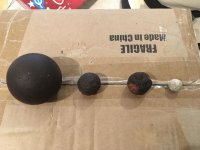Valuejet82
Newbie
Hey Everyone.
New member here but I’ve been lurking for a while. I was hoping you can help ID this. My father was hunting a few years ago and came across what he thought was a RW cannon ball and grape shot. See pics below and the RW grapeshot (the one on the left). Anyway I was looking at them and I wanted to see what your thoughts were as I have my doubts. The possible cannon ball is 2.25lbs and has a 7 7/8 inch circumference. The grape shot weighs 3.5oz and both were found near Monmouth battlefield in Freehold NJ. The other grape shot was found near Fort Ticonderoga and weighs 2.7 oz. the .69 caliber musket ball is their for reference. (It as also found near Ticonderoga.) Anyway thanks for any help you can provide.
New member here but I’ve been lurking for a while. I was hoping you can help ID this. My father was hunting a few years ago and came across what he thought was a RW cannon ball and grape shot. See pics below and the RW grapeshot (the one on the left). Anyway I was looking at them and I wanted to see what your thoughts were as I have my doubts. The possible cannon ball is 2.25lbs and has a 7 7/8 inch circumference. The grape shot weighs 3.5oz and both were found near Monmouth battlefield in Freehold NJ. The other grape shot was found near Fort Ticonderoga and weighs 2.7 oz. the .69 caliber musket ball is their for reference. (It as also found near Ticonderoga.) Anyway thanks for any help you can provide.










